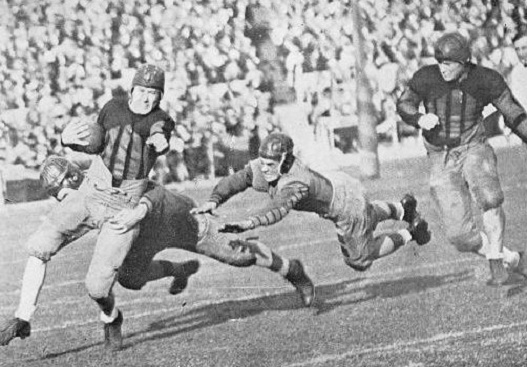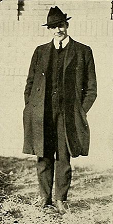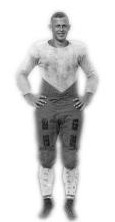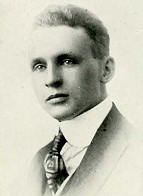
Top 25 Rankings 1901-1935
1925 National Championship
Home
1925
College Football Top 25

Pictured
above is Alabama halfback Johnny Mack Brown about to
break free for a long gain against Washington in the Rose Bowl. Alabama
won a great game 20-19 to finish 10-0 and lay claim to the school's
first mythical national championship (MNC). However, 8-0 Dartmouth was
widely regarded as the mythical national champion (MNC) at the time,
and if there had been an AP poll in 1925, Dartmouth would have finished
ranked #1 by a landslide vote. In fact, Alabama would not have even been rated #2 in a post-bowl poll for the 1925 season.
I think a post-bowl AP poll would have rated 8-0 Dartmouth #1, 7-1
Michigan #2, 10-0 Alabama #3, and 8-1 Pittsburgh #4, and I think that's
logically viable, so that's how this hypothetical 1925 AP poll top 25
will begin. I
summarized
all 4 of those teams and compared them in detail in my 1925 national championship article.
After
the top 4, this was a very difficult top 25 to put together. It
required a lot of work, and I went through many permutations on the way
to this final list. The nation was very deep in strong football teams
in 1925, so that its top 40 was comparable to a top 25 today. As such,
I'm going to do something a little bit different for this top 25. After
I put together the top 25, I'm going to rank the next 15 teams in
order, giving us a top 40.
#5: Colgate vs. West Virginia
I
suspect that 7-0-2 Colgate and 5-1-1 Princeton would have been next in
line, followed by 8-1 West Virginia. Colgate was tied by 2
lower-rated teams, 7-1-1 Lafayette (will be #11) and 5-4-1 Brown (not top 40), and Princeton lost
to Colgate and was tied by 5-2-1 Navy (#31). West Virginia, on the other
hand, took no upset, their only loss coming 15-7 at #4 Pittsburgh. West
Virginia defeated 6-2-1 Washington & Jefferson 19-0, Washington
& Jefferson beat Lafayette, and Lafayette, again, tied Colgate. So
West Virginia should be ranked ahead of Colgate.
But so should Washington & Jefferson. 6-2-1 Washington &
Jefferson took their losses to #4 Pittsburgh (by just 6-0 on the road)
and to West Virginia. They took an upset tie to 5-2-1 Carnegie (will be #35), but
they defeated 7-1-1 Lafayette 7-6 in New York City. Colgate took 2
upset ties, one of them to Lafayette, whom W&J defeated. So
Washington & Jefferson's relevant record was effectively half a game better than that of Colgate on the season.
And Colgate's "upset" tie to Lafayette wasn't even an upset, or at
least, it wasn't a tie to a lesser team. It was the other way around,
because Lafayette should be ranked higher than Colgate as well.
Lafayette's only loss came 7-6 to Washington & Jefferson, whom I
just established should be ranked higher than Colgate. Lafayette tied
Colgate, but took no other losses or ties, whereas Colgate was tied in
their finale by 5-4-1 Brown. On top of
that, Lafayette notched a huge upset win 20-9 at #4 Pittsburgh.
So 6-2-1 Washington & Jefferson > 7-1-1 Lafayette > 7-0-2
Colgate > 5-1-1 Princeton. As such, I'll put off discussing Colgate
and Princeton further until I get down to Washington & Jefferson
and Lafayette.
West Virginia #5. Their 19-0 win over Washington & Jefferson
was their only significant win, but after their 15-7 loss at #4 Pitt in
game 3, no one came close to West Virginia, and none of their 9
opponents finished with a losing record this season (opponents 53-24-2).
Washington and Stanford
Next up would
have likely been 10-1-1 Washington and 7-2 Stanford, and that works
fine. Washington lost by 1 point to #3 Alabama in the Rose Bowl, and
they took an upset tie to 4-2-2 Nebraska (will be #19). Stanford's
losses came to Washington and to the Olympic Athletic Club, who was
5-0. Their big win came 13-9 at 11-2 Southern Cal.
Washington #6, Stanford #7.
#8: Southern Cal vs. Penn vs. Tulane vs. Wisconsin
Things get
cloudier here. Next in line could have been 11-2 Southern Cal, 7-2
Pennsylvania, 9-0-1 Tulane, or 6-1-1 Wisconsin. That order would be my
guess, but I don't think it works. Southern Cal and Penn each took an
upset loss, while Tulane and Wisconsin each took an upset tie, giving
them an effective half game lead on USC and Penn. And their straight
records were better too, so maybe they would have been rated higher in
the first place.
Wisconsin's tie came at 5-2-1 Minnesota (will
be #14), and Tulane's tie came to 6-1-1 Missouri (will be #18) at home.
Wisconsin defeated 5-3 Iowa (#17) and 3-4-1 Chicago (#29), and Tulane
defeated 5-3 Northwestern (#30), so there's an edge for Wisconsin. But
Wisconsin had a weak win (7-0 over 3-4-1 Purdue), while all of Tulane's
wins came by more than a touchdown. So I think you could go with either
team here. Since Tulane had the better straight record, and I suspect
they would have been rated higher anyway, we'll go with Tulane.
As
for 11-2 Southern Cal, they took an ugly upset loss 17-12 to 3-4-1
Washington State at home. 6-3 California's straight record may not look
as impressive, but they took no upset losses (they lost to 5-0 Olympic
Athletic Club, #6 Washington, and #7 Stanford), and they beat
Washington State 35-0. So I can't see USC being rated ahead of Cal, and
as such, I'll move them back there.
7-2 Penn is a similar story.
I don't see why their 24-2 home loss to 5-3 Illinois should be
considered an upset at all, and they should be ranked behind Illinois.
So that's where I'll move them.
Tulane #8, Wisconsin #9.
Tulane


Tulane
was coached by Hall of Famer Clark Shaughnessy (pictured above at left), who went 59-28-7 at
Tulane 1915-1920 and 1922-1926, winning 2 conference titles (one of
them this season, shared with Alabama). He had played end for
Minnesota, and was a substitute on their 1911 team, which I see as that season's MNC. He would win another MNC as coach of Stanford in 1940, and overall he was 151-114-18 in 32 seasons at 7 schools.
The
star player was halfback Charles "Peggy" Flournoy (pictured above at right), who also handled the
punting and placekicking. He was a nonconsensus All American this
season, leading the nation in scoring with 128 points (19 touchdowns).
He was voted the national MVP by the Veterans Club of America.
Tulane was invited to the Rose Bowl this season, but they turned it down, and the bid fell to Alabama.
Washington & Jefferson, Lafayette, Colgate, and Princeton
Now we can bring
in this previously-discussed foursome. 6-2-1 Washington & Jefferson
defeated 7-1-1 Lafayette 7-6 in New York City. Lafayette tied 7-0-2
Colgate, but Colgate took an upset tie to 5-4-1 Brown (not top 40), and
Lafayette had a big upset win over #4 Pittsburgh, so Lafayette should
be ranked higher than Colgate. Colgate won 9-0 at 5-1-1 Princeton, who
also took an upset tie to 5-2-1 Navy (will be #31). Princeton's big win
was 25-12 at 5-2-1 Yale (will be #23).
Washington & Jefferson #10, Lafayette #11, Colgate #12, and Princeton #13.
The Big Victory Chain Circle
If things were cloudy before, now we're socked in by a thick fog. Here's the big victory chain circle:
5-2-1 Minnesota won 33-0 over 5-3 Iowa, who won 12-10 over 5-3 Illinois,
who won 24-2 at 7-2 Penn, who won 16-13 at 5-2-1 Yale, who won 28-7
over 7-2 Army, who won 27-0 over 7-2-1 Notre Dame in New York City, who
won 19-7 at Minnesota.
I think an AP poll would have rated 7-2 Penn and 7-2 Army the
highest of these teams, but 5-2-1 Minnesota is the team that should
rise to the top. Minnesota's other loss came to #2 Michigan, and they
tied #9 Wisconsin. That tie with a higher-ranked team gave them a
relevant record that was effectively half a game better than Penn's.
Minnesota's effective lead over Army was even bigger, because Army took
a 21-7 upset loss to 6-3-1 Columbia (will be #34) in New York City.
7-2-1 Notre Dame, who beat Minnesota, took a 17-0 loss at 4-2-2
Nebraska (#19) in their finale, and they also took an ugly tie at 4-4-1
Penn State (not top 40).
Putting Minnesota at the top gives us the victory chain as ordered above:
Minnesota > Iowa > Illinois > Penn > Yale > Army >
Notre Dame. But there are other teams that need to be placed in the
spaces between these teams, so let's put them in place a chunk at a
time...
Minnesota, Cal, Southern Cal, and Iowa
As
previously noted, 6-3 Cal took no upset losses, while 11-2 Southern Cal
was upset by 3-4-1 Washington State (Cal beat WSU 35-0), so I can't see
USC being rated ahead of Cal. Since Minnesota took an upset loss, to
7-2-1 Notre Dame (will be #25), Cal could be rated higher than
Minnesota as well. However, Cal did not beat any team as strong as
Notre Dame themselves, or any top 25 team, and Minnesota tied #9
Wisconsin, so Minnesota being rated higher is also an option, and since
that is the way an AP poll would certainly have gone, that's what we'll
go with here.
Southern Cal defeated Iowa, so naturally they
should be rated ahead of Iowa. I doubt very much that 5-3 Iowa would
have been rated in an AP poll top 25 at all for 1925, and they were a
sticking point for a long time when I was putting this together. They
are almost worth disregarding, because they lost big in their last 2
games, 33-0 at Minnesota and 18-0 at USC, and their big win, 12-10 over
5-3 Illinois, was a very close home win. But Iowa also lost to #9
Wisconsin by just 6-0, and their other 4 wins were dominating,
including 15-0 at 4-3-1 Ohio State (will be #28). Illinois only beat
Ohio State 14-9, so I can't quite see dismissing Iowa's win over
Illinois as an anomaly.
Minnesota #14, California #15, Southern Cal #16, and Iowa #17.
Missouri, Nebraska, and Illinois
6-1-1 Missouri beat 4-2-2 Nebraska 9-6 at home, and Nebraska won 14-0 at 5-3 Illinois, so Missouri > Nebraska > Illinois.
Missouri
tied 9-0-1 Tulane (#8) on the road in their opener, and they were upset
10-7 at bitter rival Kansas (2-5-1) in their finale. Nebraska was even
more erratic. They lost 14-0 at Drake (5-3, not top 40) and they tied
0-0 at Kansas State (5-2-1, not top 40), terrible results, but in
addition to beating Illinois 14-0 on the road in their opener, they
tied 10-1-1 Washington (#6) and they defeated 7-2-1 Notre Dame (will be
#25) 17-0 in their finale.
5-3 Illinois took no upsets, their
losses coming to Nebraska, #17 Iowa, and #2 Michigan. Their big win was
24-2 at 7-2 Penn (will be #21), and they also beat 4-3-1 Ohio State
(#28) and 3-4-1 Chicago (#29). This was legendary halfback Red Grange's
senior season at Illinois.
Missouri #18, Nebraska #19, and Illinois #20.
Rounding Out the Top 25: Penn, Cornell, Yale, Army, and Notre Dame
Now we're at the
bottom of our big victory chain. 7-2 Penn won 16-13 at 5-2-1 Yale, who
won 28-7 over 7-2 Army, who beat 7-2-1 Notre Dame 27-0 in New York
City. And butting their way into the middle is 6-2 Cornell. Cornell was
trounced by #1 Dartmouth 62-13, but then no one came close to Dartmouth
this year, and Dartmouth was saving their "real" offense for the
Cornell game. Cornell's other loss came 7-0 at Penn. They beat 6-3-1
Columbia (will be #34) 17-14 in New York City, and they won the rest of
their games by an average score of 46-0. 5-2-1 Yale was tied at 4-3-1
Harvard (not top 40) in their finale, and Cornell did not take an
upset, so we'll slide Cornell in behind Penn and ahead of Yale.
7-2-1 Notre Dame actually had a better relevant record than did 7-2
Army. Army beat Notre Dame, but they also took an upset loss to 6-3-1
Columbia (#34). Notre Dame defeated a higher-ranked team, #14
Minnesota, putting them an effective game better than Army. Notre Dame
was also tied by 4-4-1 Penn State (not top 40), leaving them still an
effective half game ahead of Army overall. However, Army's win over
Notre Dame was very decisive, 27-0, and their loss to 6-3-1 Columbia,
ranked #34, was not necessarily a worse result than Notre Dame's tie
with 4-4-1 Penn State, who was not rankable at all. Notre Dame's 17-0
loss at #19 Nebraska, a poor performance, came in their last game,
giving it extra weight. A 1925 AP poll would have ranked Army higher
than Notre Dame, and that is viable.
Pennsylvania #21, Cornell #22, Yale #23, Army #24, and Notre Dame #25.
Others
Receiving Votes (#26-40)
As promised, this time I'm ranking the "Others Receiving Votes" teams in order, so you get a bonus for 1925: a top 40. As I noted earlier, I believe a top 40 for 1925 is comparable to a top 25 today.
#26: Hawaii 10-0

Too bad I
couldn't find room for 10-0 Hawaii, but there was just no getting past
#25 Notre Dame, who beat #14 Minnesota. Hawaii didn't accomplish
anything like that. In fact, Hawaii only beat one winning major team,
though it was a pretty good one, 41-0 over Rocky Mountain champion
Colorado State (9-1, will be #37). And Hawaii won all their games by
more than a touchdown,
their average score an impressive 42-2. They also beat 3-4-1 Washington State
20-11, and while that was not impressive in itself, #16 Southern Cal
lost to WSU, so I could see Hawaii being rated higher than them (at
least). But a 1925 AP poll would not have done so, and Hawaii's
schedule gives good enough reason for that. Southern Cal actually beat
a top 25 team, and 3 top 40 teams.
Hawaii
was coached by Oregon State grad Otto Klum (pictured above), who went
84-51-7 in 19 seasons at Hawaii 1921-1939. This team was called the
"Wonder Team," a rip-off of California's Wonder Teams 1920-1924, and
their backfield was called the "Four Horsemen of Hawaii," obviously
another rip-off.
#27: St.
Mary's (California) 8-2
The only losses
St. Mary's took came 6-0 at #15 Cal and 12-0 at #16 Southern Cal, so
they might well have been the #17 team this year, but they didn't play
anyone else of value, so we'll never know. The average score in their
wins was 39-7.
#28: Ohio State 4-3-1
Ohio State's losses came to #2 Michigan, #17 Iowa, and #20 Illinois,
and they tied 3-4-1 Chicago (#29). They won 10-3 over 7-1-1 Ohio
Wesleyan (#33) and 9-0 over 6-3-1 Columbia (#34).
#29: Chicago 3-4-1
Chicago's losses
came to #1 Dartmouth, #9 Wisconsin, #20 Illinois, and #21 Penn. They
tied 4-3-1 Ohio State (#28) 3-3 at home. Chicago's best wins were 9-0
over 6-3 Kentucky (not top 40) and 6-0 over 5-3 Northwestern (#30).
#30: Northwestern 5-3
Northwestern's
losses came to #8 Tulane, #25 Notre Dame, and #29 Chicago. They really
only accomplished one thing this season, but it was huge, a 3-2 upset
win in a rainstorm over #2 Michigan, costing them an MNC. Otherwise,
Northwestern performed poorly over weak opponents, and if it wasn't for
that win, they would not even be considered for a top 40. But they did
get that win, and they avoided taking any upset losses in their weak
performances, so here they are at #30.
#31: Navy 5-2-1
Navy was similar
to Northwestern in that they accomplished little beyond one big result.
Navy's losses came to #2 Michigan and #24 Army, and their one big
result was a 10-10 tie with #13 Princeton in Baltimore. Obviously that
pales compared to Northwestern's win over Michigan (Michigan beat Navy
54-0), so Navy comes in behind Northwestern.
#32: Syracuse 8-1-1
8-1-1 Syracuse
is the only one of these "Others Receiving Votes" teams that would
certainly have been ranked in a 1925 AP poll top 25. But obviously I
feel that they do not merit such a ranking. Why? Well, their one big
win came over 6-3-1 Columbia (#34), which doesn't get them very far,
and they were tied by 7-1-1 Ohio Wesleyan (#33), which drags them down
to Wesleyan's level. Ohio State defeated Ohio Wesleyan, Chicago tied
Ohio State, Northwestern beat #2 Michigan, and Navy tied #13 Princeton.
Syracuse has little reason to be ranked ahead of any of those teams,
and plenty of reason to be ranked behind them with Ohio Wesleyan, who
tied Syracuse 3-3 on the road. Syracuse's loss came to #12 Colgate.
Syracuse may have been a top 25 caliber team, but their schedule didn't
afford them much opportunity to show it.
#33 Ohio Wesleyan 7-1-1

In their only
games against major teams, Ohio Wesleyan lost 10-3 at #28 Ohio State
and they tied at #32 Syracuse. They won all the rest of their games by
more than a touchdown, average score 30-2.
Ohio
Wesleyan first adopted their nickname, the "Battling Bishops," this
season, and it may have been the best season in the school's football
history. The coach was George Gauthier (pictured above), who had played
quarterback for Michigan State's unbeaten 1913
MNC contender. He went 4-3 in one season as coach at his alma mater,
and then he went 121-98-15 in a long career at Ohio Wesleyan 1921-1946.
He won 2 conference titles, and he made national news in one other
season aside from this one, beating Michigan 17-7 in Ann Arbor in 1928.
Gauthier is in the Helms Foundation Hall of Fame.
#34 Columbia 6-3-1
Columbia's
losses came to #22 Cornell, #28 Ohio State, and #32 Syracuse, and they
were tied by 6-2-1 New York (not top 40). Columbia's one big win came
21-7 over #24 Army (7-2).
#35 Carnegie 5-2-1
Carnegie's
losses came to #4 Pittsburgh and #25 Notre Dame. Their one big
accomplishment was a 0-0 tie at #10 Washington & Jefferson.
#36 Georgetown 9-1
Georgetown put up some impressive scores, but their schedule was fairly
light, and they took a 3-2 loss to 7-3-1 Bucknell (not top 40) at home.
But they won 27-0 at 8-1 Fordham (#38) and 24-0 at 5-4 Detroit.
#37 Colorado State 9-1
Rocky Mountain
champion Colorado State's loss came 41-0 at #26 Hawaii. Needless to
say, they didn't beat anyone of value, but their scores were fairly
impressive, and they did win 13-0 at 6-1 Utah State. CSU was coached by
Harry Hughes for 3 decades 1911-1941, and I covered him in some detail
in the CSU section of my 1915 national championship article. 1915 is the only season CSU has finished with a perfect record.
#38 Fordham 8-1
Fordham's loss came 27-0 to #36 Georgetown at home. They won 26-6 over
6-2-1 NYU and 17-0 over 8-2 Holy Cross, and they put up some big
scores, but they also performed very poorly in a 13-7 win at 2-6-1 John
Carroll (Ohio).
#39 Oregon State 7-2
Oregon
State's losses came to #7 Stanford and #16 Southern Cal. Their best win
came 22-0 over 7-2-2 Gonzaga, which is worth very little. But all of
their wins came by more than a touchdown (average score 37-4), so they
might have been top 25 caliber. Their schedule leaves that a mystery.
#40 Louisville 8-0

A
token spot for Louisville. They were almost certainly not actually the
#40 team, and probably not top 60, but hey, they were 8-0, so why not?
At this time they were the equivalent of division 2 or lower. They
scraped by 4 times, 6-0 at Western Kentucky, 6-0 over Kentucky
Wesleyan, 7-0 over Transylvania (Kentucky), and 7-2 at Marshall.
Louisville
started playing football in 1912, but due to lack of money they dropped
the sport 1917-1920. This year they were coached by Tom King, a Notre
Dame grad who was in his first season, and what a start! Unfortunately
it didn't last, and King went 19-21 in his next 5 seasons to finish his
short career at 27-21.
The star player was halfback Fred Koster
(pictured above), a good punter, passer, and open field runner. He had
been considered too small to play for his high school team, and weighed
in at 160 pounds in college. In 1926 he would score 68 points in his
first 2 games, drawing national attention. He finished that season with
124 points on 18 touchdowns, 10 extra points, and 2 field goals. He
went on to a 10 year career playing pro baseball.
1925
Top 25
1)
Dartmouth 8-0
2) Michigan 7-1
3) Alabama 10-0
4) Pittsburgh 8-1
5) West Virginia 8-1
6) Washington 10-1-1
7) Stanford 7-2
8) Tulane 9-0-1
9) Wisconsin 6-1-1
10) Washington & Jefferson 6-2-1
11) Lafayette 7-1-1
12) Colgate 7-0-2
13) Princeton 5-1-1
14) Minnesota 5-2-1
15) California 6-3
16) Southern Cal 11-2
17) Iowa 5-3
18) Missouri 6-1-1
19) Nebraska 4-2-2
20) Illinois 5-3
21) Pennsylvania 7-2
22) Cornell 6-2
23) Yale 5-2-1
24) Army 7-2
25) Notre Dame 7-2-1
Others
Receiving Votes:
26) Hawaii 10-0
27) St. Mary's (California) 8-2
28) Ohio State 4-3-1
29) Chicago 3-4-1
30) Northwestern 5-3
31) Navy 5-2-1
32) Syracuse 8-1-1
33) Ohio Wesleyan 7-1-1
34) Columbia 6-3-1
35) Carnegie 5-2-1
36) Georgetown 9-1
37) Colorado State 9-1
38) Fordham 8-1
39) Oregon State 7-2
40) Louisville 8-0






